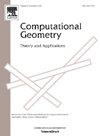Approximation algorithms for 1-Wasserstein distance between persistence diagrams
IF 0.4
4区 计算机科学
Q4 MATHEMATICS
Computational Geometry-Theory and Applications
Pub Date : 2025-03-25
DOI:10.1016/j.comgeo.2025.102190
引用次数: 0
Abstract
Recent years have witnessed a tremendous growth using topological summaries, especially the persistence diagrams (encoding the so-called persistent homology) for analyzing complex shapes. Intuitively, persistent homology maps a potentially complex input object (be it a graph, an image, or a point set and so on) to a unified type of feature summary, called the persistence diagrams. One can then carry out downstream data analysis tasks using such persistence diagram representations. A key problem is to compute the distance between two persistence diagrams efficiently. In particular, a persistence diagram is essentially a multiset of points in the plane, and one popular distance is the so-called 1-Wasserstein distance between persistence diagrams. In this paper, we present two algorithms to approximate the 1-Wasserstein distance for persistence diagrams in near-linear time. These algorithms primarily follow the same ideas as two existing algorithms to approximate optimal transport between two finite point-sets in Euclidean spaces via randomly shifted quadtrees. We show how these algorithms can be effectively adapted for the case of persistence diagrams. Our algorithms are much more efficient than previous exact and approximate algorithms, both in theory and in practice, and we demonstrate its efficiency via extensive experiments. They are conceptually simple and easy to implement, and the code is publicly available in github.
持久图之间1-Wasserstein距离的近似算法
近年来,使用拓扑摘要,特别是持久化图(编码所谓的持久化同源)来分析复杂形状的情况有了巨大的增长。直观地说,持久化同构将潜在的复杂输入对象(图形、图像或点集等)映射到统一类型的特征摘要,称为持久化图。然后可以使用这种持久性图表示执行下游数据分析任务。一个关键问题是如何有效地计算两个持久化图之间的距离。特别地,持久性图本质上是平面上的多点集,一个流行的距离是所谓的持久性图之间的1-Wasserstein距离。在本文中,我们提出了两种近似近似1-Wasserstein距离的算法。这些算法主要遵循与现有的两种算法相同的思想,通过随机移动四叉树来近似欧几里德空间中两个有限点集之间的最优传输。我们将展示如何将这些算法有效地应用于持久性图。我们的算法在理论和实践上都比以前的精确和近似算法有效得多,我们通过大量的实验证明了它的有效性。它们在概念上很简单,易于实现,代码在github上公开可用。
本文章由计算机程序翻译,如有差异,请以英文原文为准。
求助全文
约1分钟内获得全文
求助全文
来源期刊
CiteScore
1.60
自引率
16.70%
发文量
43
审稿时长
>12 weeks
期刊介绍:
Computational Geometry is a forum for research in theoretical and applied aspects of computational geometry. The journal publishes fundamental research in all areas of the subject, as well as disseminating information on the applications, techniques, and use of computational geometry. Computational Geometry publishes articles on the design and analysis of geometric algorithms. All aspects of computational geometry are covered, including the numerical, graph theoretical and combinatorial aspects. Also welcomed are computational geometry solutions to fundamental problems arising in computer graphics, pattern recognition, robotics, image processing, CAD-CAM, VLSI design and geographical information systems.
Computational Geometry features a special section containing open problems and concise reports on implementations of computational geometry tools.

 求助内容:
求助内容: 应助结果提醒方式:
应助结果提醒方式:


